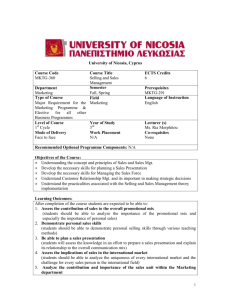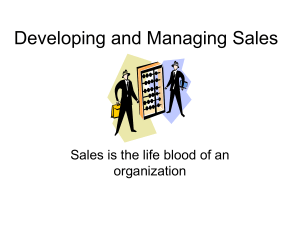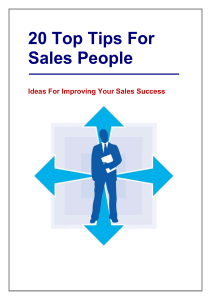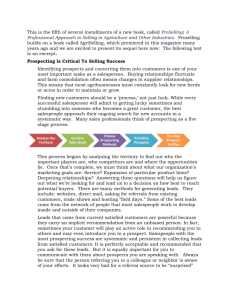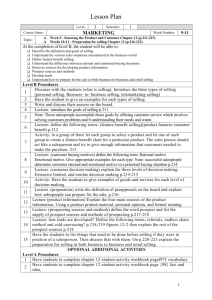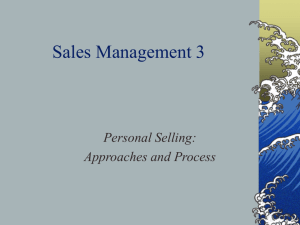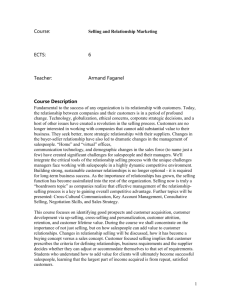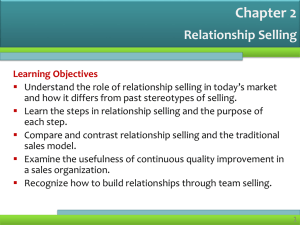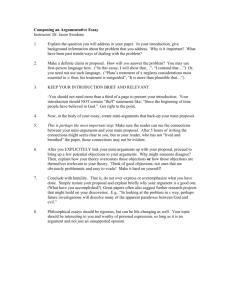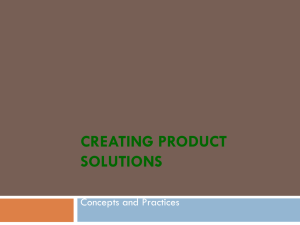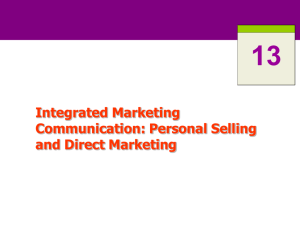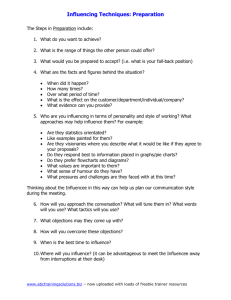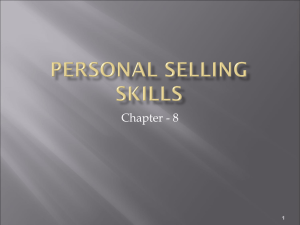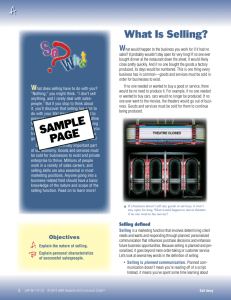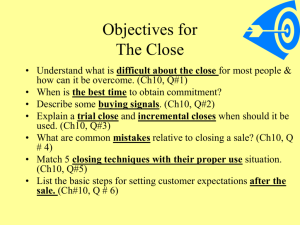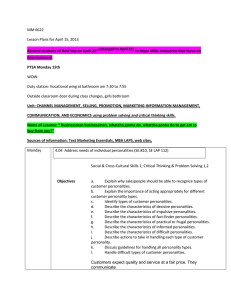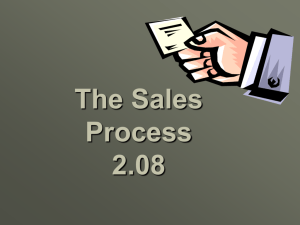MK342 - Southeast Missouri State University
advertisement
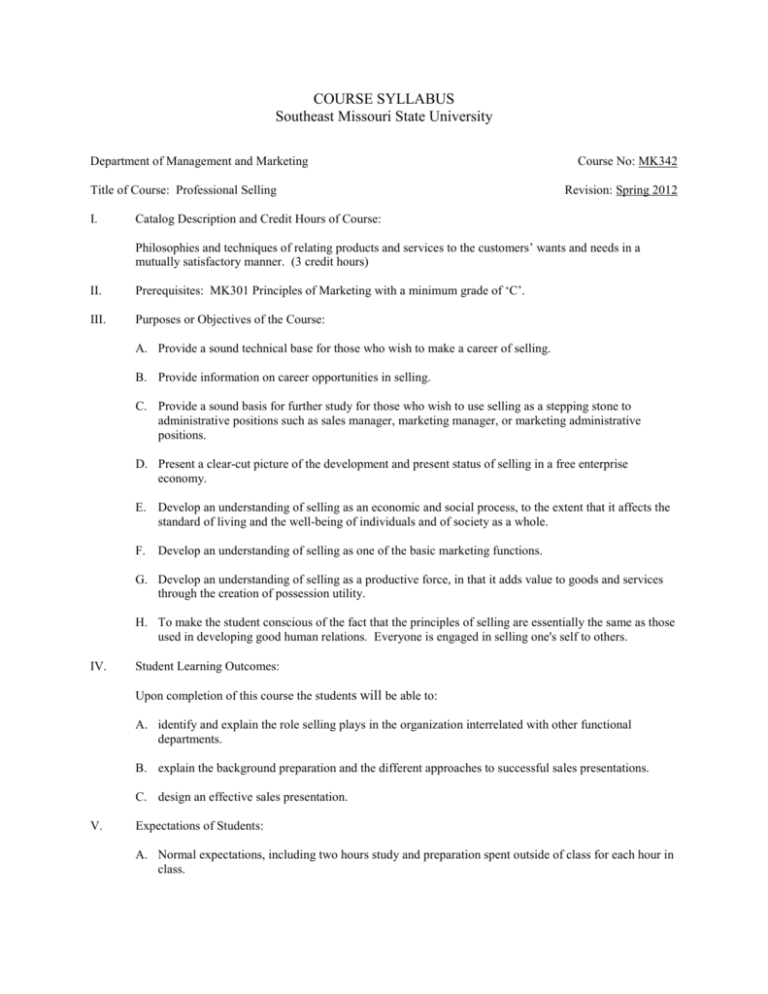
COURSE SYLLABUS Southeast Missouri State University Department of Management and Marketing Title of Course: Professional Selling I. Course No: MK342 Revision: Spring 2012 Catalog Description and Credit Hours of Course: Philosophies and techniques of relating products and services to the customers’ wants and needs in a mutually satisfactory manner. (3 credit hours) II. Prerequisites: MK301 Principles of Marketing with a minimum grade of ‘C’. III. Purposes or Objectives of the Course: A. Provide a sound technical base for those who wish to make a career of selling. B. Provide information on career opportunities in selling. C. Provide a sound basis for further study for those who wish to use selling as a stepping stone to administrative positions such as sales manager, marketing manager, or marketing administrative positions. D. Present a clear-cut picture of the development and present status of selling in a free enterprise economy. E. Develop an understanding of selling as an economic and social process, to the extent that it affects the standard of living and the well-being of individuals and of society as a whole. F. Develop an understanding of selling as one of the basic marketing functions. G. Develop an understanding of selling as a productive force, in that it adds value to goods and services through the creation of possession utility. H. To make the student conscious of the fact that the principles of selling are essentially the same as those used in developing good human relations. Everyone is engaged in selling one's self to others. IV. Student Learning Outcomes: Upon completion of this course the students will be able to: A. identify and explain the role selling plays in the organization interrelated with other functional departments. B. explain the background preparation and the different approaches to successful sales presentations. C. design an effective sales presentation. V. Expectations of Students: A. Normal expectations, including two hours study and preparation spent outside of class for each hour in class. B. Additional emphasis on class participation due to the use of cases, problems, exercises and/or projects. VI. Course Content or Outline Approximate Hours Part I - Selling as a Profession A. The Life, Times, and Career of the Professional Salesperson 1. What Is Selling? 2. What Salespeople Are Paid to Do 3. Why Choose a Sales Career? 4. Is a Sales Career Right for You? 5. Success in Selling — What Does It Take? 6. Relationship Selling 7. Sales Jobs Are Different 8. What Does a Professional Salesperson Do? 9. The Future for Salespeople 10. Building Relationships Through the Sales Process 3 B. Relationship Marketing: Where Personal Selling Fits 1. What Is Marketing? 2. Customer Orientation’s Evolution 3. Marketing’s Importance in the Firm 4. Essentials of a Firm’s Marketing Effort 5. Relationship Marketing 6. Relationship Marketing and the Sales Force 7. Levels of Relationship Marketing 8. Partnering with Customers 9. The New Consultative Selling 10. E-Selling: Technology and Information Build Relationships 11. What’s a Salesperson Worth? 12. The Key to Success 3 C. Social, Ethical, and Legal Issues in Selling 1. Management’s Social Responsibilities 2. What Influences Ethical Behavior? 3. Management’s Ethical Responsibilities 4. Ethics in Dealing with Salespeople 5. Salespeople’s Ethics in Dealing with Their Employers 6. Ethics in Dealing with Customers 7. The International Side of Ethics 8. Managing Sales Ethics 3 Part II - Preparation for Relationship Selling D. The Psychology of Selling: Why People Buy 1. Why People Buy—The Black Box Approach 2. Psychological Influences on Buying 3. A FABulous Approach to Buyer Need Satisfaction 4. How to Determine Important Buying Needs—A Key to Success 5. The Trial Close—A Great Way to Uncover Needs and SELL 6. SELL Sequence 7. Your Buyer’s Perception 8. Perceptions, Attitudes, and Beliefs 9. The Buyer’s Personality Should Be Considered 10. Adaptive Selling Based on Buyer’s Style 11. You Can Classify Buying Situations 4 12. 13. 14. 15. Technology Provides Information View Buyers as Decision-Makers Satisfied Customers Are Easier to Sell To To Buy or Not to Buy—A Choice Decision E. Communication for Relationship Building: It’s Not All Talk 1. Communication: It Takes Two 2. Nonverbal Communication: Watch for It 3. Barriers to Communication 4. Master Persuasive Communication to Maintain Control 2 F. 3 Sales Knowledge: Customers, Products, Technologies 1. Sources of Sales Knowledge 2. Knowledge Builds Relationships 3. Know Your Customers 4. Know Your Company 5. Know Your Product 6. Know Your Resellers 7. Advertising Aids Salespeople 8. Sales Promotion Generates Sales 9. What’s It Worth? Pricing Your Product 10. Know Your Competition, Industry, and Economy 11. Personal Computers and Selling 12. Knowledge of Technology Enhances Sales and Customer Service 13. Sales: Internet and the World Wide Web 14. Global Technology Provides Service 15. Technology Etiquette Part III - The Relationship Selling Process G. Prospecting—The Lifeblood of Selling 1. The Sales Process Has 10 Steps 2. Steps Before the Sales Presentation 3. Prospecting—The Lifeblood of Selling 4. Where to Find Prospects 5. Planning a Prospecting Strategy 6. Prospecting Methods 7. Prospecting Guidelines 8. The Prospect Pool 9. The Referral Cycle 10. Call Reluctance Costs You Money! 11. Obtaining the Sales Interview 12. Wireless E-Mail Helps You Keep in Contact and Prospect 3 H. Planning the Sales Call Is a Must! 1. Strategic Customer Sales Planning—The Preapproach 2. The Prospect’s Mental Steps 3. Overview of the Selling Process 2 I. 2 Carefully Select Which Sales Presentation Method to Use 1. Sales Presentation Strategy 2. Sales Presentation Methods—Select One Carefully 3. Sales Presentations Go High Tech 4. Let’s Review Before Moving On! J. Begin Your Presentation Strategically 1. The Right to Approach 2. The Approach—Opening the Sales Presentation 3. Technology in the Approach 4. Using Questions Results in Sales Success 5. Is the Prospect Still Not Listening? 6. Be Flexible in Your Approach 2 K. Elements of a Great Sales Presentation 1. The Purpose of the Presentation 2. Three Essential Steps Within the Presentation 3. The Sales Presentation Mix 4. Visual Aids Help Tell the Story 5. Dramatization Improves Your Chances 6. Demonstrations Prove It 7. Technology Can Help! 8. The Ideal Presentation 9. Be Prepared for Presentation Difficulties 3 L. Welcome Your Prospects Objections 1. Welcome Objections! 2. What Are Objections? 3. When Do Prospects Object? 4. Objections and the Sales Process 5. Basic Points to Consider in Meeting Objections 6. Six Major Categories of Objections 7. Techniques for Meeting Objections 8. Technology Can Effectively Help Respond to Objections! 9. After Meeting the Objection–What to Do? 2 M. Closing Begins the Relationship 1. When Should I Pop the Question? 2. Reading Buying Signals 3. What Makes a Good Closer? 4. How Many Times Should You Close? 5. Closing Under Fire 6. Difficulties With Closing 7. Essentials of Closing Sales 8. Prepare Several Closing Techniques 9. Prepare a Multiple-Close Sequence 10. Close Based on the Situation 11. Research Reinforces These Sales Success Strategies 12. Keys to Improved Selling 13. The Business Proposition and the Close 14. When You Do Not Make the Sale 3 N. Service and Follow-Up for Customer Retention 1. Super Salespeople Discuss Service 2. Relationship Marketing and Customer Retention 3. The Product and Its Service Component 4. Customer Satisfaction and Retention 5. Excellent Customer Service and Satisfaction Require Technology 2 Part IV - Managing Yourself, Your Career, and Others VII. O. Time, Territory, and Self-Management: Keys to Success 1. Customers Form Sales Territories 2. Elements of Time and Territory Management 2 P. Planning, Staffing, and Training Successful Salespeople 1. Transition from Salesperson to Sales Manager 2. Technology Is Needed in the Job 3. Being a First-Line Sales Manager Is a Challenging Job 4. What Is the Salary for Management? 5. Overview of the Job 6. Sales Management Functions 7. Sales Force Planning 8. Staffing: Having the Right People to Sell 3 Q. Motivation, Compensation, Leadership, and Evaluation of Salespeople 1. Motivation of the Sales Force 2. The Motivation Mix: Choose Your Ingredients Carefully 3. Compensation Is More Than Money 4. The Total Compensation Package 5. Nonfinancial Rewards Are Many 6. Leadership Is Important to Success 7. Performance Evaluations Let People Know 8. Sales Managers Use Technology 3 Textbooks and/or Other Required Materials or Equipment: Futrell, Charles M. (2008), Fundamentals of Selling Customers for Life, 10th Edition. New York: Irwin/McGraw-Hill. VIII. Basis of Student Evaluations A. Videotaped Interactive Sales Presentation B. Term Paper/Project. C. Performance on Periodic Exams. D. Performance on Final Exam. E. Performance on Quizzes. F. Article summaries. G. Day-In-The-Field Experience. H. ACT! CRM Software Exercise I. Case Studies
